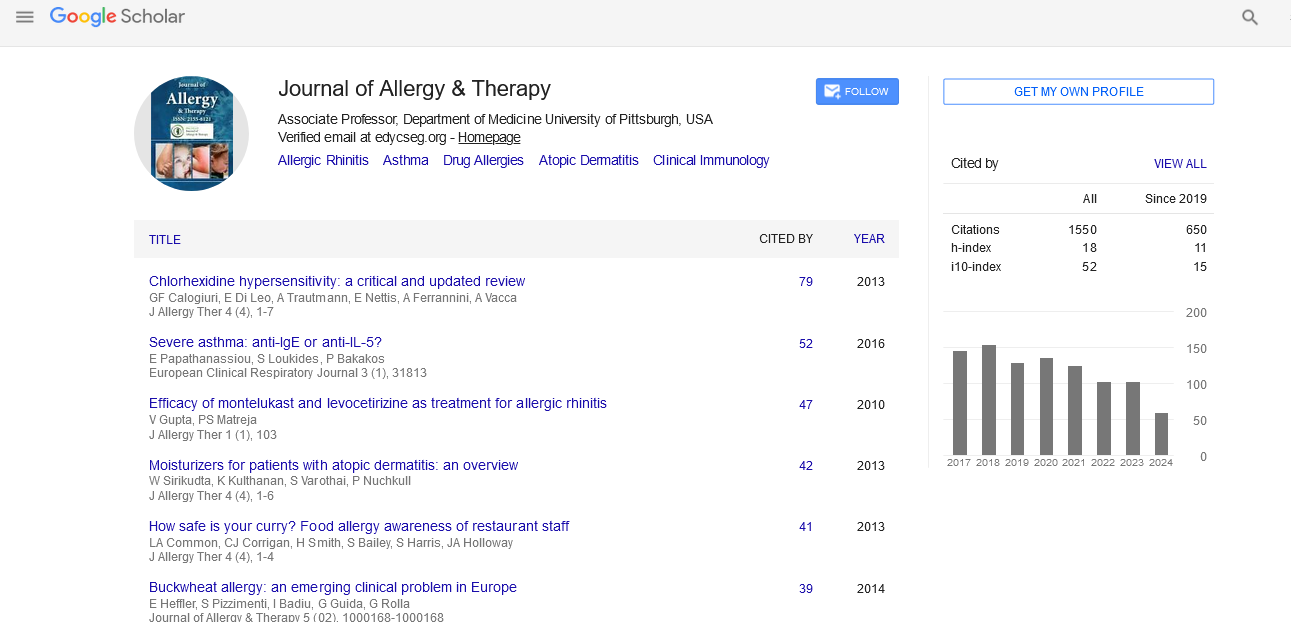Indexed In
- Academic Journals Database
- Open J Gate
- Genamics JournalSeek
- Academic Keys
- JournalTOCs
- China National Knowledge Infrastructure (CNKI)
- Ulrich's Periodicals Directory
- Electronic Journals Library
- RefSeek
- Hamdard University
- EBSCO A-Z
- OCLC- WorldCat
- SWB online catalog
- Virtual Library of Biology (vifabio)
- Publons
- Geneva Foundation for Medical Education and Research
- Euro Pub
- Google Scholar
Useful Links
Share This Page
Journal Flyer

Open Access Journals
- Agri and Aquaculture
- Biochemistry
- Bioinformatics & Systems Biology
- Business & Management
- Chemistry
- Clinical Sciences
- Engineering
- Food & Nutrition
- General Science
- Genetics & Molecular Biology
- Immunology & Microbiology
- Medical Sciences
- Neuroscience & Psychology
- Nursing & Health Care
- Pharmaceutical Sciences
Co-factor augmented anaphylaxis
13th International Conference on Allergy and Clinical Immunology
December 13-14, 2018 Abu Dhabi, UAE
Vincent St Aubyn Crump
Manchester University NHS Foundation Trust, United Kingdom
Keynote: J Allergy Ther
Abstract:
Anaphylaxis is an acute, life-threatening, systemic reaction caused by mediators released from different cells. The underlying mechanisms of anaphylaxis can be several with the key players being specific IgE, mast cells, and basophils. Co-factors are factors which when present during anaphylaxis makes the anaphylaxis possible, or more severe. The Augmenting factors like exercise, alcohol, infections, antacids and menstrual cycle; the concomitant diseases like asthma, mastocytosis and cardiac disease and cofactors like allergens, betablockers can be risk factors for anaphylaxis. The other major risk factors for severe anaphylaxis might be age, sex, pre-existing medical conditions and antihypertensive drugs. Other than cofactors; mediators, pathways and cell types can also serve as factors for anaphylaxis. Human anaphylaxis can be generally classified as immunologic, non-immunologic and idiopathic. The classification is based on factors and causes. The talk covers some examples of known cofactors for anaphylaxis and also the prevalence of co-factor augment anaphylaxis. Certain cases studies on wheat-dependent exercise induced anaphylaxis, co-factor associated anaphylaxis and LTP Syndrome will be covered.
Biography :
Vincent St Aubyn Crump is a consultant allergist at Manchester University Hospital NHS Foundation Trust and setting the only allergy service in Jamaica. He has written a number of review articles on allergy, developed Patient Education Aids and frequently participates in public and professional presentations on allergy in New Zealand and UK. He has constantly been working on expanding the database for his allergy website: www.allergyclinic.co.nz. He has published a book "Allergies New Zealand's Growing Epidemic" in 2009. The book has been described by Penny Jorgensen, CEO of Allergy New Zealand, as ‘a must have book for every New Zealander’. Dr Crump’s book offers an in-depth examination on the treatment of allergies and the ways in which allergic conditions are interrelated. It also includes case studies illustrating how allergies manifest themselves and a wealth of practical advice on how to recognize allergies and where to look for the most effective treatment options. To address the growing gap between the rising prevalence of allergies and the shortage of allergy specialists in New Zealand, the idea of AllergyDoctor was considered the most realistic solution to improving the unmet needs of allergy service in New Zealand. The core structure of AllergyDoctor is to train/up skill general practitioners in allergy. They are trained to be proficient in comprehensive allergy assessment, skin prick testing, patch testing and administering immunotherapy, safely and effectively.


